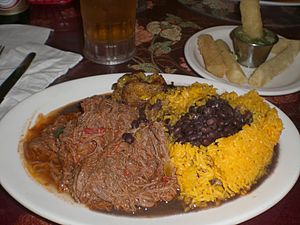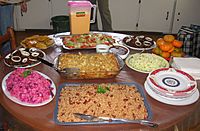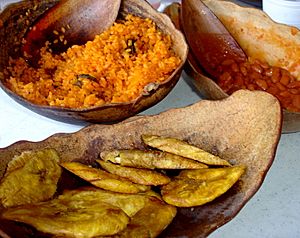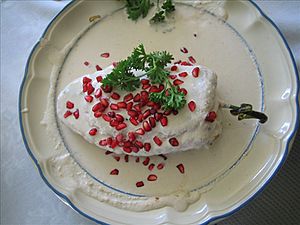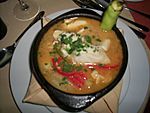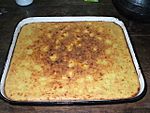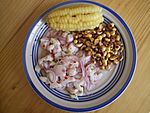Latin American cuisine facts for kids
Latin American cuisine is all about the delicious foods, drinks, and cooking styles found in many countries across Latin America. This huge area has lots of different cultures, and each one has its own special dishes.
Some common foods you'll find in Latin American cuisine include dishes made from maize (corn), like arepas, pupusas, tacos, tamales, and tortillas. They also love different kinds of salsas and dips, such as guacamole, pico de gallo, mole, and chimichurri. A special cooking base called Sofrito is also very popular. It's a sauce made from tomatoes, bell peppers, garlic, onions, and herbs. And don't forget rice and beans – they are a staple in many Latin American meals!
The drinks in Latin America are just as unique as the food. Some of these drinks have been around since the time of the Native Americans! Popular choices include coffee, mate, hibiscus tea, horchata, chicha, atole, and aguas frescas.
Desserts in Latin America are usually very sweet. You might find treats like dulce de leche, alfajor, rice pudding, tres leches cake, and flan.
Contents
Cultural Influences on Latin American Food
Latin American food has been shaped by many different cultures over hundreds of years.
Native American Influence
Long ago, the first people living in the Americas, called Native Americans, had their own ways of cooking. They grew important crops like corn and beans in Mexico and Central America. These are still used today in dishes like pupusas, tamales, and corn tortillas. In South America, Native Americans grew potatoes, corn, and chuño. These ingredients are found in modern dishes like arepas and locro.
African Influence
When Africans came to Latin America, they brought their cooking traditions and skills. They often had to use less popular parts of meat, like intestines. They found ways to clean and season these parts to make them tasty. For example, the dish Menudo came from this practice. In South America, leftover food scraps were often combined to create new dishes, which are now part of national cuisines.
European Influence
Europeans also brought their food traditions. They quickly started using fruits and vegetables that were native to the Americas in their own cooking. The main European influences come from Spain, Portugal, and Italy. You can also see smaller influences from French, British, German, and Eastern European foods, especially in countries like Argentina and Uruguay.
Asian Influence
Later, immigrants from Asia, like China and Japan, also influenced Latin American food, especially in Peru and Brazil. The Chinese brought their own spices and cooking styles, which were welcomed. Many Asian restaurants in Latin America even started mixing their food with local styles. A good example is Peruvian chifa, which is Chinese food with a Peruvian twist.
Caribbean Cuisine
Caribbean food is a mix of Native American, African, and European cooking styles. These traditions came from the many different people who settled in the region.
Seafood is very common in the Caribbean islands because they are surrounded by the ocean. Each island often has its own special seafood dish, like lobster or certain types of fish. Barbados, for example, is famous for its "flying fish."
Rice is another Caribbean favorite, but it's prepared differently on each island. Some people season their rice or add peas and coconut. It can be a side dish or part of a main meal.
Cuba
Cuban food is a unique blend of Spanish, African, and Caribbean flavors. Cuban recipes use spices like cumin, oregano, and bay leaves, similar to Spanish and African cooking. They also use local foods like tropical fruits, root vegetables, and fish. A small Chinese influence means that steamed white rice is often eaten with meals. Rice is so important that Cubans usually eat it for lunch and dinner almost every day.
Unlike Mexico, Cuba doesn't use tortillas much. Instead, they have casave, a flatbread made from yuca root. It's cooked lightly and then air-dried to keep for a long time.
Haiti
Haitian cuisine is a mix of Native Taino, French, and Spanish cooking, along with African influences. For example, French baguettes are a common food in Haitian cities. A special dish called soup joumou (pumpkin soup) is traditionally eaten on New Year's Day.
Rice and beans are staple foods in Haiti and are usually part of every meal. Poultry is more popular than pork or other meats. Seafood is very popular in coastal towns. Haiti also has delicious fruits and nuts from its mountains.
Puerto Rico
Puerto Rican food comes from the cooking traditions of Europe (Spain), Africa, and the Native American Taínos.
When the Spanish arrived in 1493, they brought new foods from around the world. While some of these foods didn't grow well, others like plantains, bananas, and coffee became very important to Puerto Rican food culture.
Later, in the late 1800s, the United States also influenced Puerto Rican cuisine. Today, you can find Puerto Rican food in many countries outside the island.
Central American Cuisine
Belize
People in Belize eat many different foods. Breakfast often includes homemade bread, flour tortillas, or fry jacks, eaten with cheese, refried beans, and eggs. This meal is called "drinking tea."
Midday meals can be lighter, like rice and beans (sometimes with coconut milk), tamales, or meat pies. Bigger dinners often feature rice and beans, meat, and salad. In rural areas, meals might be simpler. The Maya people use a lot of corn in their meals, and the Garifuna people love seafood, cassava, and vegetables.
Costa Rica
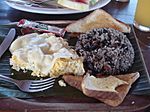
The main food in Costa Rica is gallo pinto, which is a mix of rice and black beans. Many families eat it for all three meals of the day!
Other common foods include corn tortillas, white cheese, and picadillos. Tortillas are eaten with most meals. Picadillos are dishes where diced vegetables (like potatoes or squash) are mixed with beef and spices.
El Salvador
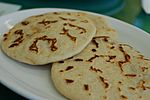
Salvadoran cuisine comes from El Salvador and mixes traditional Pipil cooking with European influences. Many dishes are made with maize (corn).
El Salvador's most famous dish is the pupusa. It's a thick, handmade corn or rice flour tortilla filled with cheese, fried pork rinds, refried beans, or a vine flower bud called loroco. You can also find vegetarian pupusas with squash or garlic.
Other popular dishes are yuca frita (deep-fried cassava root served with pickled cabbage and pork rinds) and panes rellenos (warm turkey sandwiches).
Guatemala

The food in Guatemala is very diverse, changing depending on the region. Guatemala has 22 different areas, and each has its own special foods. The candy from Antigua Guatemala is also very famous.
Some foods are traditionally eaten on certain days of the week. For example, on Thursdays, people often eat "paches," which are like tamales made with potato. On Saturdays, it's traditional to eat tamales.
Honduras

Honduran food combines Spanish, Caribbean, and ancient Maya-Lenca influences. It's known for using more coconut than other Central American cuisines, in both sweet and savory dishes.
Popular regional dishes include pollo con tajadas (fried chicken with fried green banana chips), fried fish, carne asada, and baleadas. Soups are also very popular, like conch soup, bean soup, and seafood soups, often mixed with plantains, yuca, and cabbage.
Honduras also has many tropical fruits like papaya, pineapple, mango, and different kinds of bananas and plantains.
Mexico
Mexican cuisine is a mix of ancient Mesoamerican cooking and European (especially Spanish) styles. The main ingredients are still native corn, beans, and chili peppers. Europeans brought new foods like beef, pork, chicken, dairy products, and many herbs and spices.
Mexican food is known for its strong and varied flavors, colorful look, and many spices. It's deeply connected to Mexican culture and traditions. For example, the special sauce called mole is often used for holidays. Because of its rich history and cultural importance, UNESCO has even recognized Mexican cuisine as a world "intangible cultural heritage."
Most of today's Mexican food is based on traditions from groups like the Aztecs and Maya, mixed with Spanish cooking. Mexican cuisine changes a lot by region, depending on the local climate, geography, and different native groups.
Central Mexico has dishes like barbacoa, pozole, and carnitas. Southeastern Mexico is known for spicy vegetable and chicken dishes, with some Caribbean influence. States along the Pacific Ocean or Gulf of Mexico are famous for their seafood.
Some of the most famous Mexican dishes around the world include chocolate, tacos, quesadillas, enchiladas, burritos, tamales, and mole.
Nicaragua
The food of Nicaragua is a mix of Spanish, Caribbean, and ancient Native American dishes. When the Spanish arrived, they found that the native people already used many local foods.
Traditional food changes from the Pacific to the Caribbean coast. The Pacific coast uses a lot of fruits and corn, while the Caribbean coast uses seafood and coconut.
Corn is a main food in Nicaragua, used in dishes like nacatamal and indio viejo. Corn is also used for drinks like pinolillo and chicha, and in sweets. Nicaraguans also use many local fruits and vegetables like mango, papaya, banana, avocado, and yuca.
Gallo pinto is Nicaragua's national dish. It's made of red beans and rice. On the Caribbean coast, they sometimes add coconut oil or grated coconut.
Panama
Panamanian cuisine is unique and rich. Because Panama is a land bridge between two continents, it has many tropical fruits, vegetables, and herbs. Its food is also influenced by its diverse population, including Hispanic, Native Indian, European, African, Colombian, Jamaican, and Chinese cultures.
A common Panamanian diet includes seafood like crab, lobster, and squid, many kinds of chicken soup, and lots of fruit like papayas, coconuts, and bananas. They also drink chicha, a very common drink.
South American Cuisine
The middle of South America, especially the Amazonia, has many rich food products. Potatoes and plants like quinoa are often grown there. Lima, the capital of Peru, was even called the "Gastronomic Capital of the Americas" in 2006!
In the Patagonia region of Argentina, people raise lamb and venison. King crab is caught at the southern end of the continent. Tuna and tropical fish are found all around the continent.
Argentina
The food in Argentina is heavily influenced by Italian and Spanish cooking. Native foods from groups like the Quechua and Guarani also play a role.
Argentina is a major producer of meat (especially beef), wheat, corn, and milk. So, red meat is a very common part of the Argentine diet. Because many Argentines have Italian family, pizza and pasta are also very popular.
Bolivia
Bolivian cuisine mixes Spanish cooking with ancient Andean traditions. It changes a lot depending on the region. People in the high Altiplano region like spicy meals, while those in the lowlands mainly eat yucca, fish, fruits, and vegetables.
Brazil
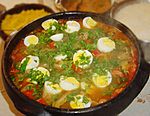
The food in Brazil is very different from one region to another. This variety shows the country's mix of Native Amerindians, Portuguese, Africans, Italians, and many other groups. This has created a national cooking style that keeps its regional differences.
Coffee is a very important part of every Brazilian's diet. Drinks like "Chimarrão" (made from yerba mate) and "cafezinho" (a super caffeinated coffee) are commonly served at meals and for snacks.
Chile
Chilean cuisine comes from a mix of traditional Spanish cuisine and native ingredients.
European immigrants also brought their cooking styles, strongly influencing Chilean food with Italian, German, and French touches. These mixtures have created a unique blend. Seafood is widely used, and many local fruits and vegetables are part of Chilean cooking. Many recipes are enjoyed with Chilean wine.
Colombia
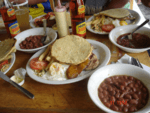
The food in Colombia has many different dishes because of the varied climates in the country. For example, in Medellín, the typical dish is the bandeja paisa. It includes beans, rice, ground meat, chorizo, a fried egg, and an arepa. It's often served with avocado and sauces.
Inland areas, the dishes show a mix of Native American and European cultures. They use local farm products, cattle, and river fish. An example is the sancocho soup.
Ecuador
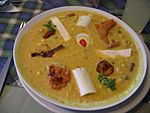
Ecuadorian food is diverse, changing with the altitude and what grows there. It's a mix of Spanish, Andean, and Amazonian cuisines, with some Italian, African, and Chinese influences.
Most regions in Ecuador follow a traditional three-course meal: soup, a second dish (like rice or pasta with meat or fish), and then dessert and coffee. Dinner is usually lighter.
Some typical coastal dishes include different kinds of ceviches, pan de yuca, and encebollado. In the mountain region, you'll find hornado, fritada, and llapingachos. Pork, chicken, beef, and cuy (guinea pig) are popular in the mountains, served with grains like rice and corn or potatoes. Fanesca, a fish soup with many types of beans, is often eaten during Lent and Easter.
Paraguay
Meat, especially beef, is a main food in Paraguay. This is clear in the Asado, a type of barbecue that's also popular in Argentina and Uruguay. Paraguayan cuisine also has unique dishes like sopa paraguaya (a savory corn cake) and Chipa Guasú (a corn grain cake).
The national drink of Paraguay is terere, a cold herbal tea. Yucca and corn are two important ingredients in Paraguayan cooking.
Peru
Peru has a very varied cuisine with ingredients like potatoes, ají peppers, avocado, and fruits like chirimoya. They also eat animals like guinea pig (called cuy). The mix of Inca and Spanish cooking traditions created new meals. Later, Chinese and Japanese immigrants in the 1800s also helped develop Creole cuisine in Lima.
Some typical Peruvian dishes are ceviche (fish and shellfish marinated in citrus juices), chupe de camarones (a soup made of shrimp), and lomo saltado (meat fried with tomato and onion, served with french fries and rice), which has a Chinese influence. Peruvian food can be enjoyed with drinks like chicha de jora (made from corn) or chicha morada (made from purple corn).
Uruguay
The food in Uruguay is based on its European roots, especially from Italy, Spain, France, Portugal, Germany, and Britain. Many foods from these countries, like pasta, sausages, and desserts, are common. The Uruguayan barbecue, asado, is very famous. A sweet spread called dulce de leche is a national favorite, used in cookies, cakes, and pancakes.
Venezuela
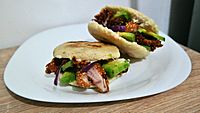
Venezuelan cuisine changes a lot from one region to another because of its diverse land and cultures. Its traditional and modern food is influenced by European, West African, and Native American traditions. Main foods include corn, rice, plantains, yams, beans, and different meats. Vegetables like potatoes, tomatoes, and onions are also common.
Traditional Eating Customs
Latin America has many different traditions linked to food. There are special days when certain foods are eaten, and many holidays are celebrated with unique meals.
Traditions
People in Latin America show thanks when they throw away extra food. Some might kiss bread before discarding it.
In Argentina and Uruguay, there's a tradition called "the Gnocchi 29." On the 29th of each month, families eat gnocchi, sometimes putting money under their plate to wish for good luck and plenty of food in the next month.
A holiday celebrated in Latin America is Three Kings Day on January 6. Families have a feast to honor Jesus.
In many Latin American countries, families eat lentils on the first day of the New Year. They believe it brings good fortune and money.
Images for kids
-
Arroz con gandules, regarded as "Puerto Rico national dish".
-
Baho, a traditional dish in Nicaragua.


